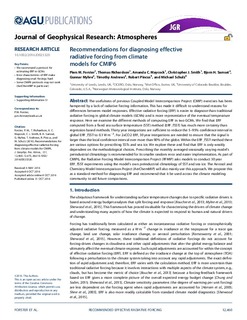| dc.contributor.author | Forster, Piers M. | |
| dc.contributor.author | Richardson, T. | |
| dc.contributor.author | Maycock, A. C. | |
| dc.contributor.author | Smith, C. J. | |
| dc.contributor.author | Samset, Bjørn Hallvard | |
| dc.contributor.author | Myhre, Gunnar | |
| dc.contributor.author | Andrews, T. | |
| dc.contributor.author | Pincus, R. | |
| dc.contributor.author | Schulz, Michael | |
| dc.date.accessioned | 2017-11-14T09:50:32Z | |
| dc.date.available | 2017-11-14T09:50:32Z | |
| dc.date.created | 2017-01-09T15:56:56Z | |
| dc.date.issued | 2016 | |
| dc.identifier.citation | Journal of Geophysical Research - Atmospheres. 2016, 121 (20), 12460-12475. | nb_NO |
| dc.identifier.issn | 2169-897X | |
| dc.identifier.uri | http://hdl.handle.net/11250/2466100 | |
| dc.description.abstract | The usefulness of previous Coupled Model Intercomparison Project (CMIP) exercises has been hampered by a lack of radiative forcing information. This has made it difficult to understand reasons for differences between model responses. Effective radiative forcing (ERF) is easier to diagnose than traditional radiative forcing in global climate models (GCMs) and is more representative of the eventual temperature response. Here we examine the different methods of computing ERF in two GCMs. We find that ERF computed from a fixed sea surface temperature (SST) method (ERF_fSST) has much more certainty than regression based methods. Thirty year integrations are sufficient to reduce the 5–95% confidence interval in global ERF_fSST to 0.1 W m−2. For 2xCO2 ERF, 30 year integrations are needed to ensure that the signal is larger than the local confidence interval over more than 90% of the globe. Within the ERF_fSST method there are various options for prescribing SSTs and sea ice. We explore these and find that ERF is only weakly dependent on the methodological choices. Prescribing the monthly averaged seasonally varying model's preindustrial climatology is recommended for its smaller random error and easier implementation. As part of CMIP6, the Radiative Forcing Model Intercomparison Project (RFMIP) asks models to conduct 30 year ERF_fSST experiments using the model's own preindustrial climatology of SST and sea ice. The Aerosol and Chemistry Model Intercomparison Project (AerChemMIP) will also mainly use this approach. We propose this as a standard method for diagnosing ERF and recommend that it be used across the climate modeling community to aid future comparisons. | nb_NO |
| dc.language.iso | eng | nb_NO |
| dc.title | Recommendations for diagnosing effective radiative forcing from climate models for CMIP6 | nb_NO |
| dc.type | Journal article | nb_NO |
| dc.type | Peer reviewed | nb_NO |
| dc.description.version | publishedVersion | nb_NO |
| dc.rights.holder | © 2016 American Geophysical Union. All Rights Reserved | nb_NO |
| dc.source.pagenumber | 12460-12475 | nb_NO |
| dc.source.volume | 121 | nb_NO |
| dc.source.journal | Journal of Geophysical Research - Atmospheres | nb_NO |
| dc.source.issue | 20 | nb_NO |
| dc.identifier.doi | 10.1002/2016jd025320 | |
| dc.identifier.cristin | 1423670 | |
| dc.relation.project | Norges forskningsråd: 229796 | nb_NO |
| dc.relation.project | Norges forskningsråd: 235548 | nb_NO |
| dc.relation.project | Notur/NorStore: nn9188k | nb_NO |
| dc.relation.project | Notur/NorStore: NS9042K | nb_NO |
| cristin.unitcode | 7475,0,0,0 | |
| cristin.unitname | CICERO Senter for klimaforskning | |
| cristin.ispublished | true | |
| cristin.fulltext | preprint | |
| cristin.qualitycode | 2 | |
